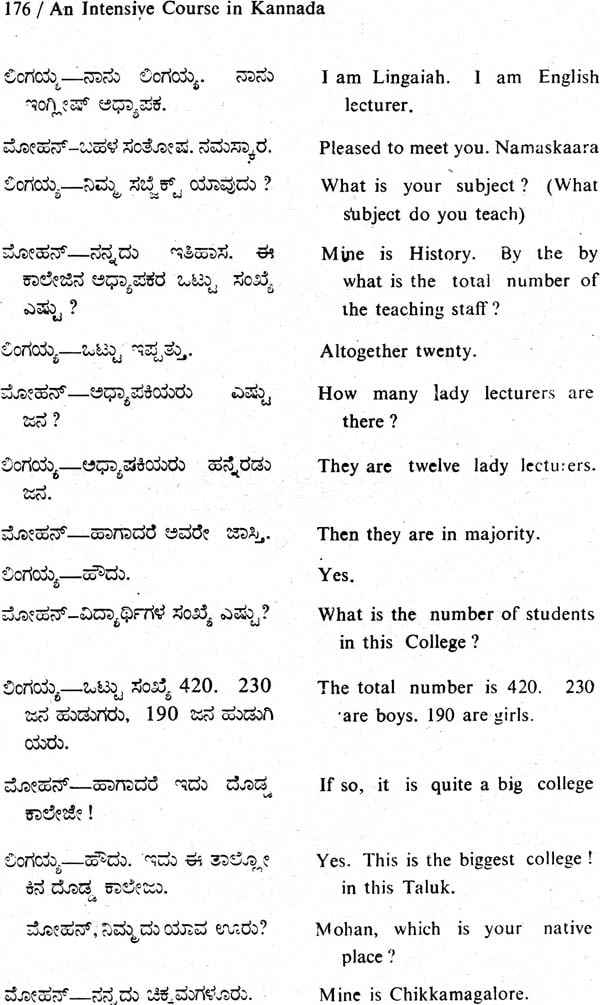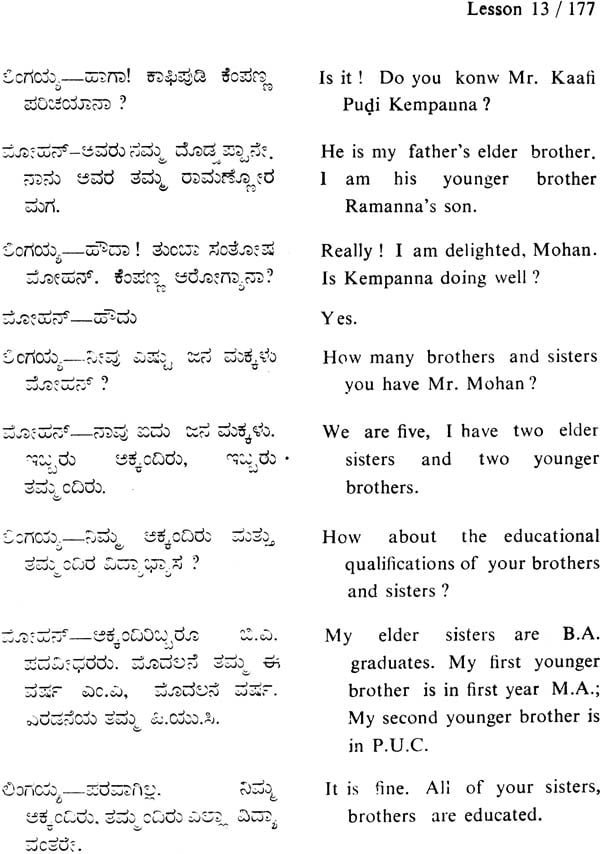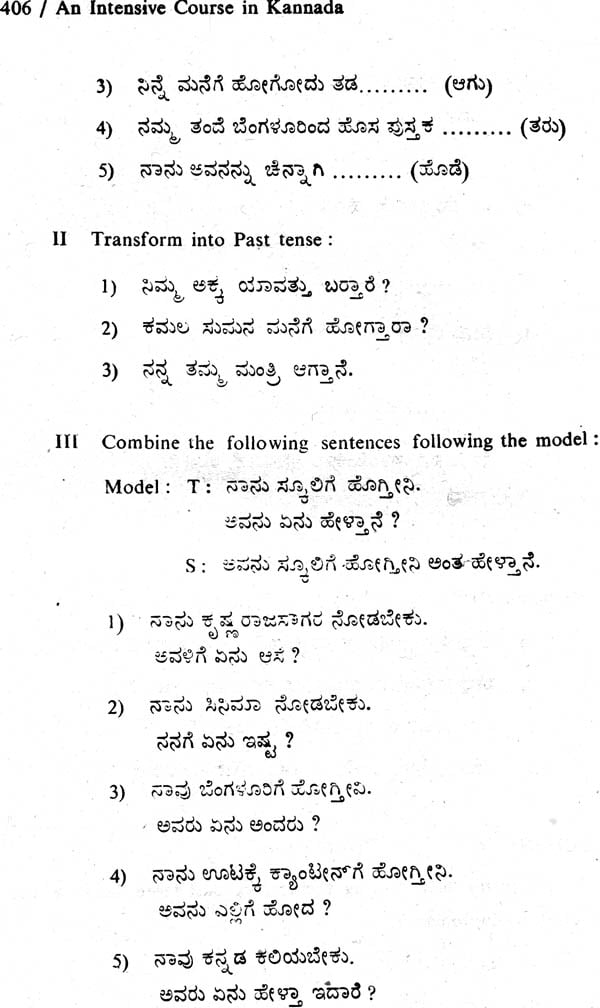
An Intensive Course in Kannada (An Old and Rare Book)
Book Specification
| Item Code: | NAK148 |
| Author: | M. N. Leelavathi |
| Publisher: | Central Institute of Indian Languages, Mysore |
| Language: | Kannada and English |
| Edition: | 1995 |
| ISBN: | 8173420319 |
| Pages: | 716 |
| Cover: | Hardcover |
| Other Details | 9.0 inch x 6.5 inch |
| Weight | 930 gm |
Book Description
The central Institute of Indian Languages was set up on the 17th July, 1969 with a view to assisting and co-ordinating the development of Indian languages. The Institute was charged with the responsibility of serving as a nucleus to bring together all the research and literary output from the various lingnistic streams to a common head and narrowing the gap between basis research and developmental research in the fields of languages and linguistics in India.
The Institute and its five Regional language Centres are thus engaged in research and teaching, which lead to the publication of a wide ranging variety of materials. Preparation of materials designed for teaching/ learning at different levels and suited to specific needs is one of the major areas of interest of the Institute. Basic research relating to the acquisition language and study of language in its manifold psycho Social relations constitute another broad range of its interest. The Publications will include materials produced by the members of the staff of the Central Institute of India Languages and its Regional Language Centres and associated scholars from universities and institution, both Indian and foreign.
The Central Institute of Indian languages has initiated an Intensive Course Series in major Indian languages to provide suitable and comprehensive material for learning and teaching the language concerned for Indians. In a language teaching situation, the teachers is expected to combine the roles of a psycho-linguist, socio linguist, linguist , language pedagogue, a creator of psycho literary critic and a testing and evaluation expert. Most of his competences are naturally reflected in the materials, which simultaneously are graded from simple to complex known to the unknown and contrived to the natural. This is a very difficult task. After research and experimentation we have come out with more questions than answers at each stage of the material.
This book, "An Intensive Course in Kannada" , is meant for the learning of Kannada is a second language. It aims at developing listening and speaking skillis in Kannada as a second language. It is intended mainly as course material for use in the kannada Training Programme for the Southern Regional Language Centre of the Central institute of Indian Languages. However care has been taken to cater to the requirements of other second language learners of Kannada also. The material here has been tried out in the classroom several times. On the basis of classroom responses suitable modifications have been incorporated.
The Regional Language Centre's training programme offers a ten-month course for the teaching of Indian language as second language. This period is divided into three stages viz, Basic Course, intermediate Course. Advanced Course. This Intensive Course is meant fer use in the basic Course. The duration of the Basic Course is 14 weeks with about 450 clock hours of instruction. The general objectives of the Basic course are as follows:
1. To perceive and reproduce the sounds and their meaningful sequences.
1. A. To identify the sounds in their meaningful sequence.
1. B. To discriminate the sounds in their meaningful sequence.
1. C. To orally reproduce the sounds in meaningful sequence.
2. To be able to form sentences orally from given patterns and lexical items.
3. To be able to converse with the teacher and with fellow trainees specified topics under controlled situations.
4. To be able to narrate specified events and topics orally.
5. To be able to read simple and graded passages with comprehension.
5. A. To be able recognise the letters of the alphabet in isolation and in sequence.
5. B. To be able to comphrened passages containing simple sentences.
6. To be able to write simple sentences and guided composition on specific topics.
6. A. To be able to write letters, words and simple sentences.
6. B. To be able to write guided compositions on specified topics.
The present book aims at covering the objectives listed under Nos. 2 to 4.
In the preparation of the present book a systematic arrangement of the linguistic and non-linguistic elements by way of selection of vocabulary items and structures, gradation of syntactic structures, and of situations has been followed. The twin principles of "from the known to unknown" and "from simple to complex" have been followed. The lessons are presented predominantly in the conversational form. However, we have also included other forms of expression such as narration and letter.
The book consists of 15 Units. A unit covers a group of related structures, Each unit is divided into several lessons, each lesson focusing on the particular structure. Care has been taken to present each of the structures in a familiar matrix, exploiting the principle of cumulative learning and presentation. Each unitcontains a reiew lesson which provides all the related structures of the unit in a natural environment. Each review lesson is followed by a test paper. The entire book is available also on tape. Instructions for the exercise parts, however, are slightly modified in the tape version.
There are 65 lessons in the book, out of which 50 are basic lessons and 15 are review lessons. The emphasis is on the standard spoken kannada, which is defined as the dialect of Kannada spoken in Bangalor Mysore area used generally by the educated speakers. Differences between modern written kannada and standard spoken Kannada dialect dialect as defined above are generally considered as minimal. The differences between modern written Kannada and the standard spoken Kannada are taken to be minimal, the spelling followed in presenting the spoken word in the printed form is generally the same as the spelling adopted in modern written kannada. However, there are certain forms such as in which the first cited ones are decidedly from the spoken language. But the current trend in the written language is to accept both the forms. Accordingly both the forms are used in the Book.
Each of the basic lessons have five components viz. The body of the lesson drills exercises, vocabulary and grammar notes.
| Foreword | v | |
| Editor's Note | vii | |
| Acknowledgement | ix | |
| Abbreviations | xix | |
| Kannada Alphabet | xxi | |
| Combinations of Vowels with consonants | xxi | |
| Unit | ||
| 1 | 1. Self Introduction I | 1 |
| 2. Self Introduction II | 8 | |
| 3. conversation with Servant | 20 | |
| 4. At Mukta's House | 32 | |
| R. L. I. In the Classroom | 47 | |
| 2 | 5. Ramayana | 57 |
| 6. Enquiry | 74 | |
| 7. Miniature India | 91 | |
| 8. Enquiry about New Cloth | 107 | |
| R. L. 2. Conversation between Friends | 127 | |
| 3 | 9. child and Mother's Conversation | 136 |
| 10. In which class are you? | 145 | |
| 11. about Naming Ceremony | 153 | |
| 12. Our Hostel Garden | 163 | |
| 13. information About College | 175 | |
| R. L. 3 At Rajanna's House | 185 | |
| 4 | 14. About Shamu's Daughter's Marriage | 189 |
| 15. Vegetable Market | 198 | |
| 16. In the Garden | 214 | |
| 17. Plan to go on a Picnic | 223 | |
| R. L. 4 Conversation Between Friends | 239 | |
| 5 | 18. Friend's Meet | 243 |
| 19. Enquiry About Anand's Brother in law | 258 | |
| 20. Enquiring About a Room in the Hotel | 269 | |
| R. L. 5 In the Cloth Shop | 284 | |
| 6 | 21. Plan to go to a Movie | 288 |
| 22. Conversation with Paper Boy | 297 | |
| 23. Gift for Ravi's Marriage | 307 | |
| 24. Enquiry about the progress of Kannada Learners | 319 | |
| R. L. 6 Enquiry About Places Around Mysore | 331 | |
| 7 | 25. Visit to the Temple | 338 |
| 26. It is not difficult to Learn Kannada | 350 | |
| 27. About Rajyotsava | 361 | |
| R. L. 7 How to go to Shalimar Theatre? | 371 | |
| 8 | 28 Ganesh Festival | 376 |
| All India Radio Programme | 384 | |
| R. L. 8 Onam Festival | 396 | |
| 9 | 30. At Son- in law's house | 401 |
| 31. Preparation to go to Class | 410 | |
| 32. Conversation with Daughter | 420 | |
| 33. About Hostel Day | 428 | |
| 34. About New Rented House | 436 | |
| R. L. 9 Enquiring About Bhaskaran's Place | 443 | |
| 10 | 35. Sunday Programme | 449 |
| 36. Conversation Between Friends | 462 | |
| 37. Mysore | 469 | |
| R. L. 10 An Incident | 480 | |
| 11 | 38. Madhu's Dairy | 484 |
| 39. Preparation to go for Convocation | 499 | |
| 40. Letter to A Colleague | 507 | |
| R. L. 11 Enquiry to go to Sight Seeing Places | 517 | |
| 12 | 41. Conversation over Telephone | 523 |
| 42. Kannada Environment Tour | 533 | |
| R. L. 12 Self Introduction III | 543 | |
| 13 | 43. About Halebid and Belur | 547 |
| 44. Language Learner's Problems | 559 | |
| 45. About Manasagangotri | 575 | |
| R. L. 13 In the Bus Stand | 588 | |
| 14 | 46. If Raju Gets Through the Examination | 593 |
| 47. Invitation to a Feast | 602 | |
| 48. I cannot Forget you | 611 | |
| R. L. 14 Thanking A Friend | 623 | |
| 15 | 49. Information About Prof. Srinivasa | 628 |
| 50. Preparation To Go To a Fair | 650 | |
| R. L. 15 Unification of Karnataka and Alur Venkata Rao | 650 | |
| Objective test Paper | 656 | |
| Structure Test Paper | 672 | |
| Word index | 677 |









